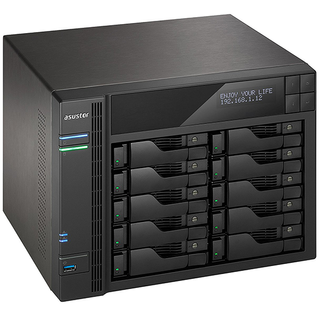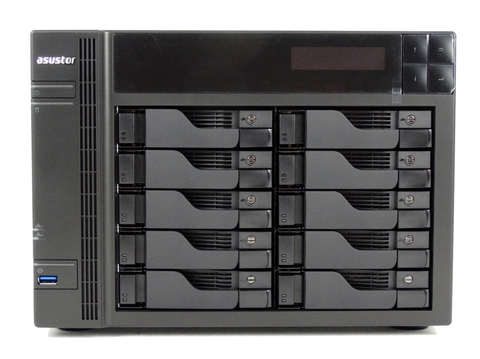Early Verdict
Pricing is both a pro and a con. The system is expensive at $999, but it also offers more than $999 in features for some users. If price is a concern, Asustor offers lower priced models with fewer drive bays. If you have a lot of data, the AS6210T delivers the highest drive count without using a rackmount. The AS6210T is feature-rich, but we would like to see more future-proof features like 10GbE.
Pros
- +
Low cost for the feature set
- +
High capacity
- +
Extensive applications
- +
Hardware encryption
- +
Best-in-class multimedia experience
- +
Dolby Atmos
Cons
- -
It's still a grand
- -
Poor random performance
- -
Lacks 10GbE options
Why you can trust Tom's Hardware
Introduction
Like the SSDs I often write about, network-attached storage (NAS) products come in different performance and capacity tiers. The Asustor AS6210T is a premium model with the ability to host large volumes of data, and it's powerful enough to deliver an amazing user experience across several connected devices at one time. For home use and medium-sized business, the Asustor AS6210T is a Tier 1 high-performance product.

Asustor's AS62 series features a quad-core Intel processor with hardware-based encryption and acceleration engines. This series also uses dual-channel memory to increase the memory bandwidth for increased application performance. The system we're testing is the flagship model with ten drive bays that support 12TB hard drives. That provides a total storage capacity of up to 120TB should you invest in the largest hard disk drives available.
The best thing about systems like the Asustor AS6210T is you don't have to populate them fully with drives during the initial setup process. You can add drives as needed and even mix drives in separate arrays. The features make the system very robust by maximizing performance for different uses. For instance, you can build a six drive RAID 5 array for long term storage and fill the remaining four drive bays with solid-state drives for virtual machines that run on remote systems across the network.
Four Gigabit Ethernet ports expand the system to separate networks, and various link aggregation methods increase system bandwidth in multi-user environments.
Specifications
Another year, another processor. The Asustor AS6210T isn't too different from the AS5108T we previously tested. The new system ships with an updated Intel system-on-chip (SoC) processor with higher performance and new features. The two systems share the same chassis design, but the 8-bay model uses a ventilated block-off plate on the top two drive bays. Sadly, you can't convert the 8-bay systems to 10-bays systems by adding two additional drive sleds--the extra SATA connectors are not soldered on the NAS's backplane.
You may have reservations about the Intel Celeron brand based on desktop product's performance, but you shouldn't compare the two despite the identical branding. The Asustor AS6210T features a powerful processor for its class that is more than enough to satisfy the needs of a high-performance NAS. We'll discuss the overall software capabilities on the next page.
The system ships with 4GB of DDR3 DRAM in SODIMM modules. The factory configuration is 2x 2GB to take advantage of the new dual-channel memory configuration. The processor is limited to 8GB of system memory, so any upgrade path should start with dual 4GB modules. We found the 4GB configuration to be more than enough to run the system as a mass storage device and media center at the same time.
The ten drive bays (eight drive bays on the similar AS6208T model) provide us with many storage options that go far beyond a simple storage appliance. The NAS supports several RAID levels, including 1, 5, 6 and 10 for disk redundancy, and RAID 0 for a high-speed array used for scratch space. With systems this large, we recommend dual disk redundancy with RAID 6, or RAID 10 for special-use scenarios like virtual machines running across the network.
The internal array uses the aging EXT4 file system. Other NAS manufacturers have adapted BTRFS, or at least made it an option, but Asustor still relies exclusively on EXT4. You can connect external drives with USB and eSATA connections. The external drives operate with the previously-formatted file system and support EXT3, EXT4, FAT32, NTFS, and HFS+.
Users have numerous options for getting data into the system, as well. The AS6210T features four gigabit Ethernet ports that can operate independently or combined via link aggregation to supply additional bandwidth to multiple users. You can even run the system with two dual-link aggregation groups, with each providing slightly over 200 MB/s of bandwidth.
Pricing & Warranty
We found the Asustor AS6210T online for as low as $999.99 at a number of online sellers. The system carries a three-year warranty.
Packaging




The system ships in a full-color retail box that lists several features and possible uses. The system sits snugly between two form-fitting closed-cell foam pieces that hug the NAS and keep the accessory box away from the system.

The accessory package includes a paper quick start guide, two Ethernet cables, a power cable and screws for both 2.5 and 3.5-inch drives. A software disk rounds out the package and includes backup software and additional manuals.
A Closer Look






The front of the AS6210T is very busy with system status LEDs, drive status LEDs on each drive sled, and even a two-line display to check system status or work through the initial configuration.
The single USB 3.0 port on the front of the system has a special one-touch copy feature. This feature copies the contents from the attached device to the NAS, be it from a cell phone or a portable hard disk drive.




The rest of the IO ports are on the back of the system. There is something for everyone and every configuration. The four USB ports allow for system expansion beyond "just" storage. The USB ports work with printers, uninterruptible power systems, and even TV tuners. Asustor designed the two eSATA ports exclusively for storage expansion.
The AS6210T supports several multimedia features coming from the system. Audiophiles will love the S/PDIF for high-quality music, but the HDMI 1.4b port will steal the show if you have a home theater. Pair the system with Kodi, and you can use the NAS as a high-end playback device that supports the two holy grail features: Dolby Atmos and DTS:X.
MORE: Best SSDs
MORE: How We Test HDDs And SSDs
MORE: All SSD Content
-
cds875 EVGA, your too hard on evga's laptop, why? because obviously they kept the cost in check with a specs down from all the Top of the Line CPU-GPU Et cetera. You recommend it? Very nice of you. It was to be a Power House of a Lap Top in the 1920x 1080 gamers like myself and MOST of the US.Reply -
ashburner Expecting my Synology 918+ to arrive tomorrow. Excited for it but I do wish it had 10gb Ethernet as wellReply -
2Be_or_Not2Be Chris, I wish you had kept your colors consistent across the different graphs. In some screens, QNAP is green; in others, it's yellow. Synology is yellow here, and green there. Consistency in the color makes it easier to comprehend, and I don't have to keep looking at the legend to see which product is which color.Reply -
2Be_or_Not2Be In this review, it seems like it's showing the Synology DS1817+ as the overall winner.Reply

